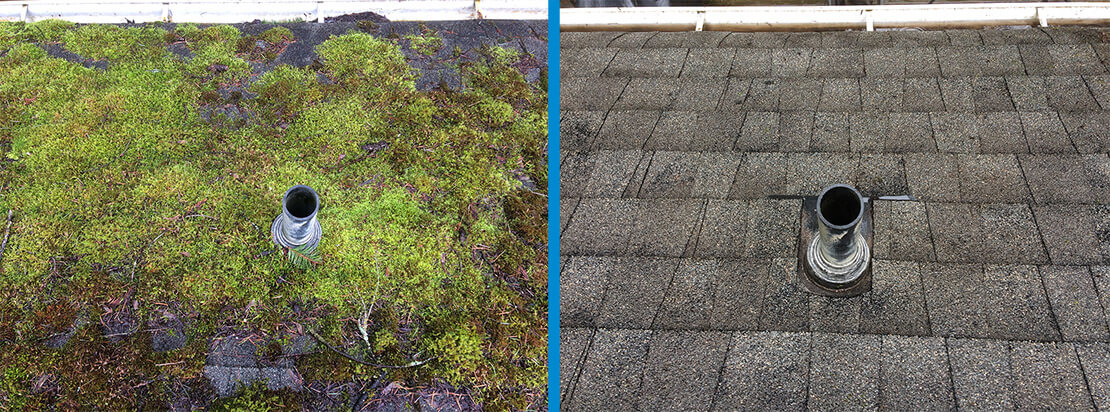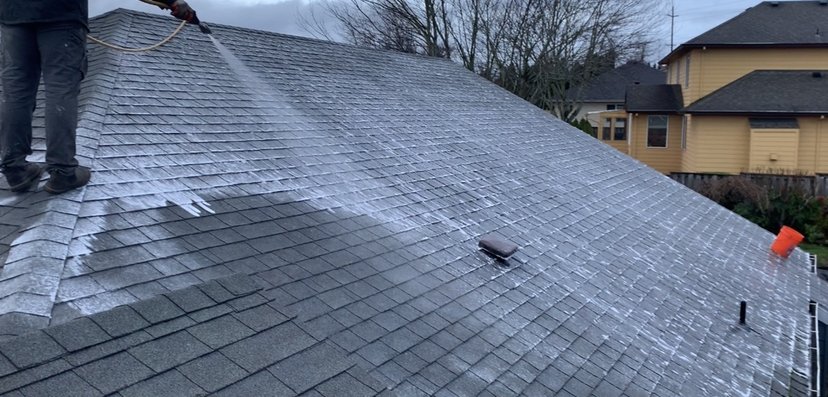Crucial Tips for Successful Moss Elimination to Boost Your Outdoor Area
Moss can be a relentless issue in exterior rooms, usually thriving in moist and shaded locations. Recognizing the underlying root causes of moss development is crucial for effective removal and avoidance. Identifying the right strategies and tools is required for tackling this concern. Additionally, preserving a healthy and balanced outdoor setting can greatly lower the opportunities of moss returning. Discovering efficient approaches can transform ignored locations right into lively landscapes. What actions can one take to assure lasting results?
Understanding the Reasons For Moss Growth
Although moss can include a picturesque high quality to landscapes, its development commonly indicates underlying issues in the environment. Usually, moss flourishes in wet, shaded locations where sunlight is limited, developing a suitable habitat for its proliferation. Poor water drainage and compacted dirt contribute substantially to its spread, as these problems keep moisture and inhibit proper water overflow. Furthermore, acidic dirt can favor moss over better plants, resulting in inequalities in the ecosystem. High humidity and regular rainfall additionally intensify the trouble, enabling moss to prosper where various other greenery struggles. Absence of competitors from grass yards can additionally promote moss development, specifically in ignored areas. Overall, comprehending the reasons of moss development is essential for reliable administration and removal, making sure that outside areas can return to their designated aesthetic and environmental function. Attending to these underlying issues is important to stop future moss invasions.
Identifying Areas Prone to Moss Build-up
Determining locations susceptible to moss buildup is crucial to efficient monitoring and prevention. Moss flourishes in environments that are damp, shaded, and have bad drain. Locations under trees or thick bushes commonly experience low sunlight, developing optimal conditions for moss growth. Additionally, regions with compacted soil, such as paths or heavily trafficked lawns, may preserve wetness, more advertising moss spreading.
Badly draining pipes surface areas like concrete or asphalt can also end up being moss hotspots, particularly in shaded areas. Home owners must routinely evaluate their outdoor rooms, seeking indicators of moss on roof coverings, outdoor patios, and yard beds. Determining these locations permits aggressive steps to be taken, such as enhancing sunshine exposure, enhancing drainage, or readjusting landscaping. By acknowledging these at risk areas, people can much better plan for and stop future moss issues, ultimately bring about a healthier and much more visually pleasing outdoor room.

Efficient Moss Elimination Strategies
Getting rid of moss properly calls for a mix of techniques customized to the specific surfaces and conditions where moss has taken hold. For hard surface areas such as driveways and outdoor patios, a stress washer can be extremely reliable, blowing up away moss without damaging the underlying product. When taking care of softer surface areas like roofing systems or wooden decks, a gentler technique is required; utilizing a soft-bristle brush and a mix of vinegar and water can assist dislodge moss without triggering harm.

Protecting Against Future Moss Development
To stop future moss growth, it is important to enhance sunshine exposure and boost drainage systems. Boosting sunlight can deter moss from growing in shaded locations, while reliable drain lessens moisture buildup. Executing these approaches can produce an environment much less favorable to moss expansion.
Enhance Sunlight Exposure
How can boosting sunlight direct exposure successfully combat future moss development? By permitting much more sunlight to get to shaded areas, property owners can substantially impede the suitable conditions that moss grows in. Moss usually embellishments in dark, damp atmospheres; as a result, boosting light schedule can disrupt its life cycle. Strategic tree trimming or removal may be required to increase sunlight in influenced locations. In addition, using reflective surface areas, such as light stones or patio area products, can better boost light infiltration. Routinely preserving and keeping an eye on garden health and wellness also guarantees that sunshine can reach the ground efficiently. Executing these actions not just minimizes the likelihood of moss regrowth yet likewise promotes a healthier, extra vivid outdoor area.

Enhance Drainage Equipments
Effective water drainage systems play a vital Web Site duty in stopping future moss development in domestic landscapes. When water builds up in particular locations, it creates a wet atmosphere for moss expansion. To boost drain, property owners must evaluate their landscape for low-lying locations and consider mounting French swales or drains to redirect excess water. Normal upkeep, such as clearing downspouts and seamless gutters, will certainly likewise promote effective water circulation. In addition, making sure that dirt is well-aerated can enhance absorption and reduce water pooling. Planting drought-resistant plant life can additionally alleviate moisture retention, producing an undesirable environment for moss. By attending to drainage concerns proactively, home owners can significantly decrease the possibility of moss holding and maintain a healthier, a lot more vivid outside space.
Choosing the Right Products for Moss Control
When selecting items for moss control, home owners need to evaluate the benefits of chemical versus natural options. Each option offers distinctive advantages and possible disadvantages, affecting performance and environmental effect. In addition, comprehending different application techniques can ensure suitable lead to moss removal initiatives.
Natural vs. Chemical Solutions
While both natural and chemical solutions provide sensible options for moss control, the option frequently depends upon specific choices, ecological considerations, and the seriousness of the moss issue. Natural solutions, such as vinegar, baking soft drink, or salt, are often favored for their eco-friendliness and low poisoning. They can effectively inhibit moss growth without hurting bordering plants or dirt health and wellness. Alternatively, chemical remedies often tend to be extra potent and can offer quicker results, making them ideal for severe infestations. Nevertheless, they might posture dangers to non-target organisms that site and the environment if misused. Eventually, the choice between natural and chemical products ought to reflect an equilibrium of performance, security, and the overall influence on the exterior room.
Application Methods Explained
Selecting the right items for moss control includes comprehending the various application approaches readily available. Property owners can pick between granular, fluid, and foam products based upon their preferences and the specific area affected by moss. Granular solutions are usually spread over the moss-infested location, enabling for gradual absorption and effectiveness. Fluid treatments, commonly used with a sprayer, deal immediate insurance coverage and penetration, making them ideal for larger areas. Foam products offer targeted application, which can be helpful for detailed surface areas like wall surfaces or roofing systems. In addition, aspects such as weather and surface type should be thought about when choosing a method. Inevitably, comprehending these methods enables effective moss control, making certain a much healthier and a lot more attractive exterior area.
Preserving a Healthy Outdoor Room After Removal
After moss elimination, it is vital to carry out effective upkeep techniques to assure the outside area remains lively and healthy. Normal lawn treatment hop over to these guys is necessary; trimming at the appropriate elevation advertises turf health and wellness and discourages moss regrowth. Furthermore, guaranteeing appropriate sunlight reaches the lawn and garden areas is essential, as moss grows in shaded atmospheres.
Soil wellness need to also be prioritized. Evaluating dirt pH and nutrient degrees can direct suitable amendments, promoting a robust environment. Proper drain is another vital variable; resolving any kind of pooling water can protect against moss from improving itself.

Frequently Asked Questions
Can Moss Be Beneficial for My Yard or Landscape?
Moss can be beneficial for gardens and landscapes by offering ground cover, keeping dampness, and improving dirt top quality. It additionally promotes biodiversity, offering habitat for tiny organisms and boosting the general aesthetic allure of outside spaces.
How much time Does It Consider Moss to Grow Back After Removal?
Moss can grow back within a few weeks to several months after elimination, depending on environmental problems like soil, moisture, and color top quality. Normal maintenance is important to prevent quick reestablishment in impacted locations.
Is Moss Elimination Hazardous to Bordering Plants or Wild Animals?
Moss elimination can possibly damage bordering plants and wild animals, specifically if chemical treatments are used. Hand-operated removal, however, usually presents very little risk, though treatment ought to be taken to prevent disturbing nearby plant life and environments during the process.
What Time of Year Is Best for Moss Elimination?
The very best time for moss elimination is normally in early spring or late fall. During these periods, temperatures are moderate, and wetness levels can help facilitate the removal process while lessening stress and anxiety on surrounding plants.
How Can I Tell if Moss Is Simply dormant or dead?
To establish if moss is dead or inactive, one must examine its shade and appearance. Healthy moss shows up vibrant and green, while dead moss often tends to be brownish and weak, lacking moisture and elasticity.
Typically, moss flourishes in moist, shaded locations where sunlight is limited, developing an optimal habitat for its proliferation. Removing moss efficiently needs a mix of strategies tailored to the specific surface areas and problems where moss has actually taken hold. Boosting sunshine can prevent moss from flourishing in shaded areas, while efficient drainage reduces moisture accumulation. By allowing more sunlight to reach shaded areas, property owners can substantially prevent the excellent conditions that moss thrives in. While both chemical and natural options provide practical alternatives for moss control, the selection usually depends on individual choices, ecological factors to consider, and the seriousness of the moss problem.